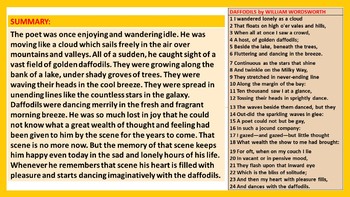
The reader then starts to notice life in everything else and in doing so this makes them feel more alive. The personification of the daffodils throughout the poem are used imaginatively, they are said to be “dancing” but they are just being blown by the wind but the activity of dancing seems to evoke a pleasant feeling, it is like the daffodils are alive, living and vivid in the reader’s mind/imagination. The speaker looks back on an experience and uses his imagination to turn it into something vivid and different. If it weren’t for the speaker’s imagination and ability to use poetic techniques to create a picture for others to read, there would be no poem. The whole poem is a recital of the speaker’s memory and requires the reader to have an imagination to truly visualise the speaker’s memory within their mind.

The form of poetry is lyrical and the rhyme scheme is ABABCC in each stanza throughout the poem and it is spoken in the first person through the speaker recalling their memories of nature. In today’s age, this poem is so important because we do not have an active engagement or appreciation for nature, we destroy it and in doing so we are destroying our happiness and replacing it with material possessions. The poem is trying to convince the reader of the positive effects of having an active engagement with nature. Without nature we all of humanity would be lonely, we would be like the cloud this is why the poem has its name. The cloud is a metaphor for the speaker and in using this metaphor it represents that humanity can be one with nature. The speaker appears to be lonely at the beginning of the poem but the presence and sight of the daffodils become ingrained in the speaker’s vivid memories. The speaker uses beautiful natural imagery to encourage the reader to appreciate the beauty of nature and what it has to offer. In the poem, humanity is a part of nature and humans having a strong bond with nature creates real and not synthetic human happiness, for example, mobile devices. The speaker is the symbol for humanity and the daffodils are the symbol of nature. The themes of this poem are nature and humanity, memory and imagination.

Throughout this poem, the speaker is admiring the natural world and its beauty. The concept of this poem is about the speaker’s joy for the beauty of daffodils and what they mean to him and mankind’s relationship to the natural world.


 0 kommentar(er)
0 kommentar(er)
